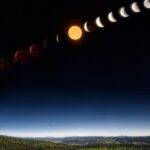Greenbelt, Md. — Stargazers are in for a treat as a rare cosmic event approaches, following the recent total solar eclipse. The stars of T Coronae Borealis (T CrB), a binary system located approximately 3,000 light years away, will be visible during an extraordinary event later in 2024, reports Space.
Rare Nova Explosion Anticipated
Astronomers are anticipating a rare nova explosion that is expected to be visible for an entire week. According to NASA, this event could occur anytime between now and September. While the precise timing is yet to be determined, astronomers assure the public that more details will follow once they’ve accurately pinpointed when the event will occur.
Once-in-a-Lifetime Experience
Nova explosions, like the one expected from T CrB, are exceptionally rare, occurring roughly once a century. For most individuals, witnessing such an event will indeed be a once-in-a-lifetime experience.
Scientific Explanation
These cosmic events occur when a collapsed white dwarf star and a red giant star come into close proximity. This closeness causes a dramatic rise in temperature on the surface of the red giant star. Typically ranging from 4,000 to 5,800 degrees Fahrenheit, temperatures during these events soar to around 360,000 degrees Fahrenheit, as reported by Earth.
Explosive Energy Release
The heightened temperature causes the red giant to expel its outer layers onto the white dwarf, resulting in a massive explosion equivalent to a nuclear bomb. This explosion releases energy approximately 100,000 times greater than the annual output of our Sun.
Cyclical Nature
Following the explosion, the star enters a cooling period before returning to its pre-explosion temperature, beginning the cycle anew. Unlike a supernova, this event does not destroy the star. T CrB and its two stars have experienced eruptions for years, with notable eruptions recorded in 1946 and 1866.
Short Duration, Bright Visibility
What makes this event unique is its complete cycle within a week. The peak brightness will make it visible to the naked eye on Earth for several days and over a week with binoculars or a telescope.
Future Occurrence
Given that the last explosion occurred in 1946, scientists estimate a roughly 79-year interval, suggesting the next event may happen around 2103.
Best Viewing Location
For optimal viewing, astronomers recommend looking within the Corona Borealis constellation, also known as the Northern Crown, situated near Bootes and Hercules, according to NASA.
Conclusion: Mark Your Calendars for a Stellar Spectacle
As anticipation builds for the rare nova explosion of T Coronae Borealis later this year, astronomers and stargazers alike eagerly await this extraordinary celestial event. With its once-in-a-lifetime occurrence and spectacular display, this cosmic phenomenon promises to captivate observers worldwide. So, mark your calendars and prepare to witness the breathtaking beauty of the universe in action. For updates and alerts on this event and more, download The Local News App to stay informed.







Leave a Reply